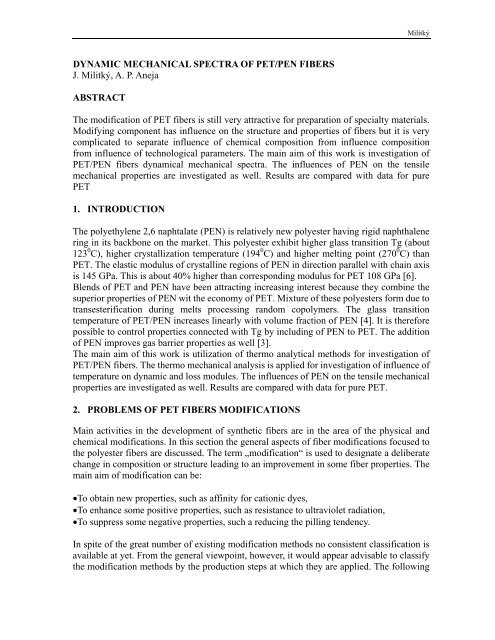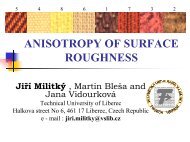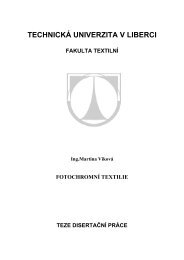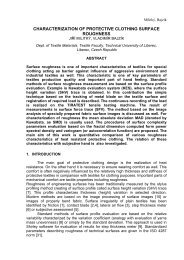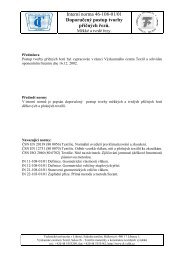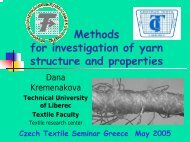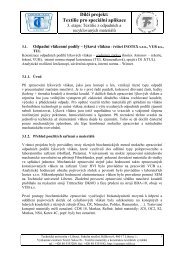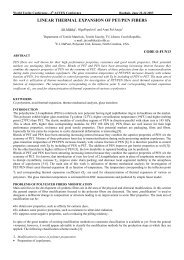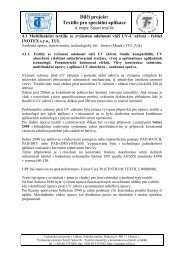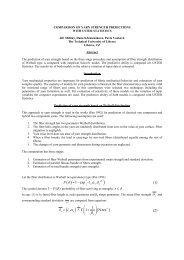DYNAMIC MECHANICAL SPECTRA OF PET/PEN ... - Centrum Textil
DYNAMIC MECHANICAL SPECTRA OF PET/PEN ... - Centrum Textil
DYNAMIC MECHANICAL SPECTRA OF PET/PEN ... - Centrum Textil
You also want an ePaper? Increase the reach of your titles
YUMPU automatically turns print PDFs into web optimized ePapers that Google loves.
Militký<br />
<strong>DYNAMIC</strong> <strong>MECHANICAL</strong> <strong>SPECTRA</strong> <strong>OF</strong> <strong>PET</strong>/<strong>PEN</strong> FIBERS<br />
J. Militký, A. P. Aneja<br />
ABSTRACT<br />
The modification of <strong>PET</strong> fibers is still very attractive for preparation of specialty materials.<br />
Modifying component has influence on the structure and properties of fibers but it is very<br />
complicated to separate influence of chemical composition from influence composition<br />
from influence of technological parameters. The main aim of this work is investigation of<br />
<strong>PET</strong>/<strong>PEN</strong> fibers dynamical mechanical spectra. The influences of <strong>PEN</strong> on the tensile<br />
mechanical properties are investigated as well. Results are compared with data for pure<br />
<strong>PET</strong><br />
1. INTRODUCTION<br />
The polyethylene 2,6 naphtalate (<strong>PEN</strong>) is relatively new polyester having rigid naphthalene<br />
ring in its backbone on the market. This polyester exhibit higher glass transition Tg (about<br />
123 0 C), higher crystallization temperature (194 0 C) and higher melting point (270 0 C) than<br />
<strong>PET</strong>. The elastic modulus of crystalline regions of <strong>PEN</strong> in direction parallel with chain axis<br />
is 145 GPa. This is about 40% higher than corresponding modulus for <strong>PET</strong> 108 GPa [6].<br />
Blends of <strong>PET</strong> and <strong>PEN</strong> have been attracting increasing interest because they combine the<br />
superior properties of <strong>PEN</strong> wit the economy of <strong>PET</strong>. Mixture of these polyesters form due to<br />
transesterification during melts processing random copolymers. The glass transition<br />
temperature of <strong>PET</strong>/<strong>PEN</strong> increases linearly with volume fraction of <strong>PEN</strong> [4]. It is therefore<br />
possible to control properties connected with Tg by including of <strong>PEN</strong> to <strong>PET</strong>. The addition<br />
of <strong>PEN</strong> improves gas barrier properties as well [3].<br />
The main aim of this work is utilization of thermo analytical methods for investigation of<br />
<strong>PET</strong>/<strong>PEN</strong> fibers. The thermo mechanical analysis is applied for investigation of influence of<br />
temperature on dynamic and loss modules. The influences of <strong>PEN</strong> on the tensile mechanical<br />
properties are investigated as well. Results are compared with data for pure <strong>PET</strong>.<br />
2. PROBLEMS <strong>OF</strong> <strong>PET</strong> FIBERS MODIFICATIONS<br />
Main activities in the development of synthetic fibers are in the area of the physical and<br />
chemical modifications. In this section the general aspects of fiber modifications focused to<br />
the polyester fibers are discussed. The term „modification“ is used to designate a deliberate<br />
change in composition or structure leading to an improvement in some fiber properties. The<br />
main aim of modification can be:<br />
•To obtain new properties, such as affinity for cationic dyes,<br />
•To enhance some positive properties, such as resistance to ultraviolet radiation,<br />
•To suppress some negative properties, such a reducing the pilling tendency.<br />
In spite of the great number of existing modification methods no consistent classification is<br />
available at yet. From the general viewpoint, however, it would appear advisable to classify<br />
the modification methods by the production steps at which they are applied. The following
Militký<br />
classification scheme results [2]:<br />
1. Modification in course of polymer preparation<br />
• Preparation of copolymers,<br />
• Using additives,<br />
• Reducing the molecular mass.<br />
2. Modification in course of fiber preparation<br />
• Drawing and setting conditions readjusting,<br />
• Speed of spinning changing,<br />
• Texturing,<br />
• Cross section geometry changing,<br />
• Fineness changing,<br />
• Bi-component and multi-component fibers production.<br />
3. Modification applied to commercial fibers<br />
• Grafting,<br />
• Plasma etching,<br />
• Controlled surface destruction.<br />
4. Combined modification<br />
(e.g. hollow microporous copolyester fibers containing additives)<br />
Details about these modifications are summarized in the book [2]. The description of<br />
modification effect on fiber properties is complicated by the fact that modification affects<br />
not only fiber structure and fiber properties but also conditions of fiber preparation. The<br />
main problems can be summarized to the following points:<br />
• It is difficult to measure structural parameters directly influencing given property (tie<br />
chain)<br />
• The properties are distinctly dependent on chemical composition of fibbers (chain<br />
flexibility)<br />
• Structural parameters are measured in static state whereas properties are usually<br />
determined in a dynamic state<br />
• Structure is changed during the measurement of some properties<br />
Influence of commoner on fiber properties can divided to the following categories<br />
A. Commoner has no effect<br />
B. Commoner has indirect effect<br />
C. Only the commoner amount matters (equilibrium melting point)<br />
D. It is the type of commoner that matters (Tg, dyeability)<br />
E. Commoner type and concentration have effect simultaneously<br />
Modification generally affect on the other technologically important characteristics as<br />
technology of fiber preparation, molecular mass of melt, degree of melt degradation and
Militký<br />
rate of crystallization. It is therefore difficult to separate effect of chemical modification<br />
from modification of technological parameters. Effect of combined physical and chemical<br />
modification on the basic structural characteristics and dyeability of modified fibers is<br />
described in the [1].<br />
3. <strong>PET</strong>/<strong>PEN</strong> FIBERS AND THEIR PREPARATION<br />
It is known, that introduction of even low level of 2,6,naphthalene units in place of<br />
terephtalate moieties acts to disrupt crystallinity, increase Tg, improve static chain packing,<br />
and decrease local segmental mobility in the amorphous phase of copolymers. These results<br />
are supported by the geometrical structure of the two units (see fig.1)<br />
O<br />
C<br />
O<br />
C<br />
O<br />
C<br />
O<br />
C<br />
0.8 nm<br />
0.57 nm<br />
A<br />
B<br />
Fig. 1 Dimensions of 2,6 naphthalene (A) and terephtalate (B) units<br />
The molar volume of <strong>PEN</strong> V <strong>PEN</strong> = 182.4 cm 3 /mol is higher than molar volume of <strong>PET</strong> V <strong>PET</strong><br />
= 144 cm 3 /mol. The amorphous density of <strong>PEN</strong> ρ a<strong>PEN</strong> = 1327 kg/m 3 is lower than<br />
amorphous density of <strong>PET</strong> ρ a<strong>PET</strong> = 1333 kg/m 3 . The crystalline density of <strong>PEN</strong> ρ c<strong>PEN</strong> =<br />
1407 kg/m 3 is lower than density of <strong>PET</strong> ρ c<strong>PET</strong> = 1440 kg/m 3 .<br />
The 2,6, naphthalene unit is substantially larger and does not fit into the unit cell of <strong>PET</strong>.<br />
The bulky kinked 2,6 naphtalene units in <strong>PEN</strong> are much less mobile than the terephtalate<br />
units. Amorphous phase free volume and local segmental mobility are reduced due to <strong>PEN</strong><br />
presence. At the temperatures around 60 0 C or higher the motion of rigid naphthalene ring<br />
occur. One possible motion is hindered rotations of the naphthalene rings about the<br />
backbone. Another possible motion is interlayer slippage of the naphthalene rings. During<br />
the deformation of <strong>PEN</strong>, the naphthalene rings are rapidly aligned parallel to the surface of<br />
the fibers and also occurs at highly localized regions. The subsequent slippage can leads to<br />
necking behavior during deformation. The naphthalene portions exhibit higher creep<br />
compliance.The fibrous samples having various content of <strong>PEN</strong> were prepared under<br />
comparable conditions. Basic characteristics of these samples are given in the table I.<br />
Table I Basic characteristic of <strong>PET</strong>/<strong>PEN</strong> samples<br />
Sample <strong>PEN</strong> content Intrinsic Boiled water Dry air-180 0 C<br />
[%] viscosity shrinkage [%] shrinkage [%]<br />
A 0 0.625 0.4 2.7<br />
B 5 0.56 1.4 4.7<br />
C 10 0.586 1.2 7.0<br />
D 15 0.582 2.2 8.4
Militký<br />
E 20 0.61 2.2 14.5<br />
It is clear than the shrinkage is increasing function of <strong>PEN</strong> content. Shrinkage is generally<br />
associated with the relaxation of the oriented amorphous chains and the removal of residual<br />
stresses formed during processing of fibers. Stress induced crystallization can reduce the<br />
shrinkage as well. Because are both shrinkage temperatures above the start of naphthalene<br />
rings motion the shrinkage processes are facilitated.<br />
4. THERMO<strong>MECHANICAL</strong> ANALYSIS<br />
In thermo mechanical analysis (TMA) the dimensional changes (expansion or contraction)<br />
are measured under defined load and chosen time The TMA requires a high-resolution<br />
measurement of the linear displacement and excellent stability of measured conditions.<br />
Most TMA instruments on the marked are not able to be sensitive to very small<br />
displacement. This was the main reason for construction of special device TMA CX 03RA/T<br />
at University of Pardubice. This device was developed to provide highly sensitive tool for<br />
reproducible measurement of subtle dimensional changes even at extremely long thermal<br />
expositions. The sample is placed on the movable sample holder connected with<br />
displacement sensor, which measures dimensional changes of the sample. The instrument is<br />
fully computer controlled with programmable time - temperature profiles and loading in<br />
static or dynamic mode. The special adapters for application of this instrument for bending<br />
and tension deformations are under preparation Described device were used for all kind of<br />
compressive measurements.<br />
Chopped material compressed in the silica oxide tube has been used for compressive creep<br />
measurement. In the table 3 are results of no isothermal creep at compressive load 100 mN<br />
and rate of heating 3 o C/min. Dependencies of height on the temperature (time) for two<br />
limit cases are given on the fig. 2. The upper line corresponds to the heating and lower one<br />
corresponds to the cooling conditions. For characterization of compressive compliance the<br />
relative height changes H c were computed<br />
H C<br />
l<br />
= 100 *<br />
20<br />
− l<br />
l<br />
20<br />
200<br />
where l 20 and l 200 are heights at 20 0 C and 200 0 C. These values are in the table II.
Militký<br />
A<br />
B<br />
Fig.2 Dependence of height on the temperature A..<strong>PET</strong> B..<strong>PET</strong>/20%<strong>PEN</strong><br />
Higher H C corresponds to the higher compressive creep compliance.<br />
Table II Parameters of non-isothermal creep<br />
Sample T tr T 1 T 2 A 1<br />
A 2<br />
H C<br />
[ o C] [ o C] [ o C] [ppm/ o C] [ppm/ o C] [%]<br />
A 114 73 111 -486.03 -9433.11 45.5<br />
B 121 93 139 -402.39 -6447.01 23.29<br />
C 122 77 146 -199.13 -6412.34 28.77<br />
D 111 80 137 -396.09 -5809.29 16.77<br />
E 115 92 135 -1209.1 -10607.9 53.6<br />
T tr is transition temperature between low and high temperature sensitive regions , T 1 is<br />
temperature of low sensitive region; T 2 is starting temperature of high sensitive response.<br />
Parameters A 1 and A 2 are sensitivity coefficients (slopes of height vs. temperature<br />
dependences. Excluding the sample E is H c decreasing function of <strong>PEN</strong> content. The<br />
compressive compliance is therefore lowered by addition of small amount of <strong>PEN</strong>.<br />
5. <strong>MECHANICAL</strong> PROPERTIES<br />
The fiber fineness has been measured on the apparatus Vibroscope (Lenzing). On the same<br />
samples the stress strain curves were evaluated by using the apparatus Vibrodyne (Lenzing).<br />
The ten various fibers have been tested. For characterization of tensile mechanical behavior<br />
the following characteristics were evaluated:<br />
P Tenacity [cN/dtex] as load at break,<br />
E Elongation [%] as deformation at break<br />
IM Initial modulus [cN/dtex] as modulus at 10% deformation<br />
SM [cN/dtex] secant modulus as 100*P/E<br />
WT [cN/dtex] toughness as P*E/50<br />
Py [cN/dtex] yield point stress as stress in point with maximal curvature on stress strain
Militký<br />
curve<br />
εy [%]yield elongation as deformation in point with maximal curvature on stress strain<br />
curve<br />
εp [%] plateau elongation as deformation corresponding the plateau in post yield region<br />
[2].<br />
Results of fineness and mechanical measurements are given in the table III. and table IV. In<br />
brackets are given coefficient of variation CV [%]. These coefficients show relatively high<br />
variability of measured characteristics mainly due to variability of geometrical<br />
characteristics of fibers (variation of titer). Very high variability has the elongation at break.<br />
This variability partially hides the influence of <strong>PEN</strong> on the mechanical characteristics.<br />
Table III. Stress strain curve parameters<br />
Sample Titer<br />
[dtex]<br />
Tenacity<br />
[cN/dtex]<br />
Elongation<br />
[%]<br />
Modulus 10%<br />
[cN/dtex]<br />
Toughness<br />
WT [cN/dtex]<br />
A 6.09 [7.2] 26.7 [10.5] 107.8 [18.2] 96.4 [13.8] 14.39<br />
B 6.84 [12.5] 24.6 [8.1] 93.7 [18.6] 87.4 [9.4] 11.52<br />
C 6.74 [20.4] 30.2 [15.7] 64.2 [29.8] 98.6 [14.3] 9.69<br />
D 6.58 [16.9] 28.6 [12.5] 52.9 [39.7] 95.7 [10.3] 7.56<br />
E 8.54 [19.4] 24.2 [12.7] 64.1 [46.3] 77.5 [11] 7.75<br />
Table IV. Parameters in yield point vicinity<br />
Sample Yield point stress Yield elongation Plateau elongation Secant<br />
Py [cN/dtex] εy [%] εp [%]<br />
[cN/dtex]<br />
A 7.9 4.1 0.1 24.95<br />
B 8.2 4.87 3.1 26.64<br />
C 8.9 5 6.2 47.04<br />
D 9.1 5.1 12.1 54.06<br />
E 7.5 4.5 14.2 37.75<br />
modulus<br />
Based on these results, the following conclusions can be formulated:<br />
1. Stress strain curves are sensitive on the <strong>PEN</strong> content. Increasing of <strong>PEN</strong> content<br />
leads to the marked appearance of yield point and wider post yield plateau εp<br />
(deformation softening region). It is known (see [2]), that εp characterize<br />
deterioration of recovery power.<br />
2. Toughness and elongation at break of fibers are decreasing function of <strong>PEN</strong> content<br />
3. Secant modulus, yield point stress and tenacity are increasing function of <strong>PEN</strong><br />
content (excluding sample E with higher titer)<br />
The <strong>PEN</strong> presence therefore acts as reinforcing of chains, and increase ultimate mechanical<br />
properties. On the other hand, the standard comonomers addition leads to decreasing of<br />
mechanical properties [2]. The post yield region exhibition is in accordance with slipping<br />
motion of naphthalene chains (necking formation).
Militký<br />
6. <strong>DYNAMIC</strong> <strong>MECHANICAL</strong> ANALYSIS<br />
The dynamic mechanical analysis (DMA) is commonly used to characterize a material in<br />
response to vibration forces. DMA enables investigation of stress (or deformation)<br />
oscillations parameters (frequency, waveform, amplitude) and temperature influence on the<br />
deformation (or stress) changes under selected mode of deformation (tensile, bending,<br />
compression etc.)<br />
The dynamic mechanical thermal spectrometer DMA DX04T developed by RMI Ltd. Czech<br />
Republic provides highly sensitive tool for reproducible measurements of fine dimensional<br />
changes during heating, cooling or even at extremely long isothermal measurements.<br />
The individual fibers were investigated in the tensile mode. Due to the high plastic<br />
deformation of fibers the process of measurement was finished after few cycles. In the<br />
second run were fibers pre deformed to strain 50 % and after that the dynamical testing were<br />
made. Temperature dependence of real modulus and loss tangent are give on the fig 3a,b.<br />
A<br />
B<br />
Fig.3 Dependence of real modulus E and tan δ on the temperature A..<strong>PET</strong> B..<strong>PET</strong>/20%<strong>PEN</strong><br />
Selected characteristics of peak on real modulus (T b and E) and peak on tan δ (tan δ m and<br />
T a ) are given in the table V.<br />
Table V Dynamic mechanical characteristics of fibers<br />
Sample T b [ 0 C] E [GPa] tan δ m [-] T a [ 0 C]<br />
A 90.4 44.3 0.35 126.9<br />
B 79.1 2.94 0.32 103<br />
C 76.1 186.8 0.274 110.6<br />
D 64.3 180.68 0.298 108.5<br />
E 68.8 190.19 0.276 109.3<br />
The content of <strong>PEN</strong> leads to decrease the temperature T b of β-relaxation process<br />
corresponding to maximum on real modulus curve. This process is caused probably by the<br />
mobility of naphthalene rings. The temperature corresponding to the maximum on tan δ<br />
characterizes the α-relaxation process (dynamic glass transition). For pure <strong>PEN</strong> the value<br />
T a =135 0 C and Tb=70 0 C have been found [8].
Militký<br />
7. CONCLUSIONS<br />
The properties of <strong>PET</strong>/<strong>PEN</strong> fibers are generally dependent on the content of <strong>PEN</strong>. A lot of<br />
properties are connected with improved thermal and mechanical characteristics due to<br />
naphthalene rings presence. On the other hand the crystalline phase is lowered and<br />
mechanical relaxation caused by the motion of naphthalene rings appeared. As results of<br />
these changes the increasing of <strong>PEN</strong> content leads to increasing of shrinkage and increasing<br />
post yield region length (strain softening region) on stress strain curves. The large loss<br />
factor found for pure <strong>PEN</strong> [9] is not observed here in the investigated range of<br />
concentrations.<br />
8. REFERENCES<br />
[1] Militký, J.: Some theoretical problems of <strong>PET</strong> fibers modifications, Proc. Int. Conf.<br />
New Fiber, Ueda July 1999<br />
[2] Militký, J. et all. : Modified Polyester Fibers, Elsevier, Amsterdam 1991<br />
[3] McDowell C.C. et all.: Synthesis, physical characterization, and acetone sorption of<br />
random <strong>PET</strong>/<strong>PEN</strong> copolymers, J. Polym. Sci. B36, 2981 (1998)<br />
[4[ Saleh Y.S., Jabarin A.: Glass transition and melting behavior of <strong>PET</strong>/<strong>PEN</strong> Blends, J..<br />
Appl. Polym. Sci. 81, 11 (2001)<br />
[5] Higashioji T., Bhusdan B.: Creep and shrinkage behavior of improved ultra thin<br />
polymeric film, J. Appl. {Polym. Sci. 84, 1477 (2002)<br />
[6] Nakamae K. et all. : Temperature dependence of the elastic modulus of the crystalline<br />
regions of <strong>PEN</strong>, Polymer 36, 1401, (1995)<br />
[7] Wu G., Cucullo J.A.: Structure and property studies of <strong>PET</strong>/<strong>PEN</strong> melt blended fibers,<br />
Polymer 40, 1011(1999)<br />
[8] Canadas J. C. et all.: Comparative study of amorphous and partially crystalline <strong>PEN</strong> ,<br />
Polymer 41, 2899 (2000)<br />
ACKNOWLEDGEMENTS<br />
This work was supported by the project LN 00 B090 of Czech Ministry of Education<br />
RESPONDENCE ADDRESS:<br />
Dept. of <strong>Textil</strong>e Materials, <strong>Textil</strong>e Faculty,<br />
Technical University of Liberec<br />
Halkova street No 6, 461 17 Liberec, Czech Republic<br />
e - mail : jiri.militky@vslib.cz


